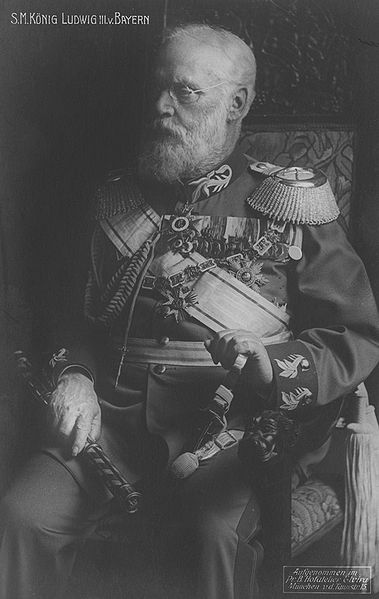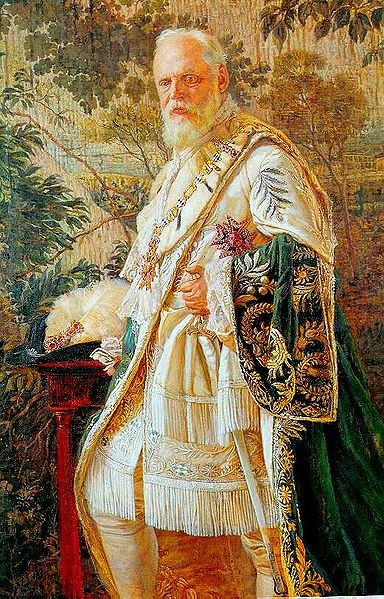<Back to Index>
- Mathematician Félix Édouard Justin Émile Borel, 1871
- Painter Albert Bierstadt, 1830
- King of Bavaria Ludwig III, 1845
PAGE SPONSOR


Ludwig III (Ludwig Luitpold Josef Maria Aloys Alfried; English: Louis Leopold Joseph Mary Aloysius Alfred), (January 7, 1845 – October 18, 1921) was the last King of Bavaria, reigning from 1913 to 1918.
Ludwig was born in Munich, the eldest son of Prince Luitpold of Bavaria and of his wife, Archduchess Augusta of Austria (daughter of Grand Duke Leopold II of Tuscany). Hailing from Florence, Augusta always spoke in Italian to her four children. Ludwig was named for his grandfather, King Ludwig I of Bavaria. Ludwig spent his first years living in the Electoral rooms of the Munich Residenz and in the Wittelsbacher Palace. When he was ten years old, the family moved to the Leuchtenberg Palace.
In 1861 at the age of sixteen, Ludwig began his military career when his uncle, King Maximilian II of Bavaria, gave him a commission as a lieutenant in the 6th Jäger battalion. A year later he entered the Ludwig Maximilians University of Munich where he studied law and economics. When he was eighteen, he automatically became a member of the Senate of the Bavarian Legislature as a prince of the royal house.
In 1866, Bavaria was allied with the Austrian Empire in the Austro-Prussian War. Ludwig held the rank of Oberleutnant; he was wounded at the Battle of Helmstedt, taking a bullet in his thigh. He received the Knight's Cross 1st Class of the Bavarian Military Merit Order In June 1867, Ludwig visited Vienna to attend the funeral of his cousin, Archduchess Mathilde of Austria (daughter of his father's sister Princess Hildegarde of Bavaria). While there, Ludwig met Mathilde's eighteen year old step-cousin Maria Theresia, Archduchess of Austria-Este. On February 20, 1868, at St. Augustine's Church in Vienna, Ludwig married Maria Theresa. She was the only daughter of the late Archduke Ferdinand Karl Viktor of Austria-Este (1821 – 1849) and of his wife Archduchess Elisabeth Franziska of Austria (1831 – 1903). Until 1862, Ludwig's uncle had reigned as King Otto I of Greece.
Although Otto had been deposed, Ludwig was still in line of succession
to the Greek throne. Had he ever succeeded, this would have required
that he renounce his Roman Catholic faith and become Orthodox. Maria Theresa's uncle, Duke Francis V of Modena, was a staunch Roman Catholic. He required that as part of the marriage agreement Ludwig renounce his rights to the throne of Greece,
and so ensure that his children would be raised Roman Catholic. In
addition, the 1843 Greek Constitution forbade the Greek sovereign to be
simultaneously ruler of another country. Consequently, Ludwig's younger
brother Leopold technically succeeded upon their father's death to the
rights of the deposed Otto I, King of Greece. By
his marriage, Ludwig became a wealthy man. Maria Teresa had inherited
large properties from her father. She owned the estate of Sárvár in Hungary and the estate of Eiwanowitz in Moravia (now Ivanovice na Hané in the Czech Republic).
The income from these estates enabled Ludwig to purchase an estate at
Leutstetten in Bavaria. Over the years, Ludwig expanded the Leutstetten
estate until it became one of the largest and most profitable in
Bavaria. Ludwig was sometimes derided as Millibauer (dairy farmer) due to his interest in agriculture and farming. Although
they maintained a residence in Munich at the Leuchtenberg Palace,
Ludwig and Maria Theresa lived mostly at Leutstetten. They had an
extremely happy and devoted marriage which resulted in thirteen
children. On the death of her uncle Francis in 1875, Maria Theresa became heir to his Jacobite claim to the throne of England, and is called either Queen Mary IV and III or Queen Mary III by Jacobites. Throughout
his life, Ludwig took a great interest in agriculture. From 1868, he
was the Honorary President of the Central Committee of the Bavarian
Agricultural Society. He was also very interested in technology,
particularly water power. In 1891 at his initiation, the Bavarian Canal
Society was established. As a prince of the royal house he was
automatically a member of the Senate of the Bavarian Legislature; there
he was a great supporter of the direct right to vote.
On December 12, 1912, Ludwig's father Luitpold died. Luitpold had been an active participant in the deposing of his nephew, King Ludwig II of Bavaria, and had also acted as Prince Regent for his other nephew, King Otto. King Otto had been judged to be mentally incapable of ruling. Ludwig immediately succeeded his father as Prince Regent. Almost
immediately there were certain elements in the press and other groups
in society which called for Ludwig to be installed as King of Bavaria
instead of Prince Regent. The Bavarian Legislature was not, however,
currently in session, and did not meet until September 29, 1913. On
November 4, 1913, the Legislature amended the constitution of Bavaria
to include a clause specifying that if a regency for reasons of
incapacity had lasted for ten years with no expectation that the king
would ever be able to reign, the regent could proclaim the end of the
regency and the demise of the crown, with such action to be ratified by
the Legislature. The amendment received broad party support in the
Lower Chamber where it was carried by a vote of 122 in favour, and 27
against. In the Senate there were only six votes against the amendment.
The next day, November 5, 1913, Ludwig announced to the Legislature the
end of the regency and deposed his cousin King Otto. The Legislature
recognised Ludwig as King Ludwig III of Bavaria. Ludwig's short reign was conservative and influenced by the Catholic encyclical Rerum Novarum. Prime Minister Georg von Hertling, appointed by Luitpold in 1912, remained in office. At the outbreak of World War I in
1914 Ludwig sent an official dispatch to Berlin to express Bavaria's
solidarity. Later Ludwig even claimed annexations for Bavaria (Alsace
and the city of Antwerp in Belgium, to receive an access to the sea).
His hidden agenda was to maintain the balance of power between Prussia and Bavaria within the German Empire after a victory. A popularly accepted
account holds that within a day or two after Germany's declaration of war, Ludwig
received a petition from a twenty-five year old Austrian, asking for
permission to join the Bavarian Army. The petition was promptly
granted, and Adolf Hitler thereupon
joined the Bavarian Army, eventually settling into the 16th Reserve
Bavarian Infantry Regiment, where he served the remainder of the war. In
1917, when Germany's situation had gradually worsened due to World War
I, Hertling became German Chancellor and Prime Minister of Prussia and Otto Ritter von Dandl was made Minister of State of the Royal Household and of the Exterior and President of the Council of Ministers on
11 November 1917, a title equivalent to Prime Minister of Bavaria.
Accused of showing blind loyalty to Prussia, Ludwig became increasingly
unpopular during the war. As the war drew to a close, the German Revolution broke
out in Bavaria. On November 7, 1918, Ludwig fled from the Residenz
Palace in Munich with his family. He was the first of the monarchs in
the German Empire to be deposed. On November 12, 1918, Prime Minister Dandl went to Schloss Anif, near Salzburg, to see the King and obtain what is known as the Anifer Erklärung (Anif declaration)
in which the King released all government officials, soldiers and civil
officers from their oath to him, but made no declaration of
resignation. The newly-formed republican government of Kurt Eisner interpreted this as an abdication. The declaration was published by the Eisner government when Dandl
returned to Munich the next day, interpreting it, somewhat ambiguously,
as the end to Wittelsbacher rule. Ludwig
III returned to Bavaria. In February 1919, Eisner was assassinated;
fearing that he might be the victim of a counter assassination, Ludwig
fled to Hungary, later moving on to Liechtenstein and Switzerland. He returned to Bavaria in April 1920 and lived at Wildenwart Castle/Chiemgau. There he remained until September 1921 when he took a trip to his castle Nádasdy in Sárvár in Hungary. He died there October 18. On
November 5, 1921, Ludwig's body was returned to Munich together with
that of his wife (who had died in February 1919). They were given a
state funeral and were buried in the crypt of the cathedral.